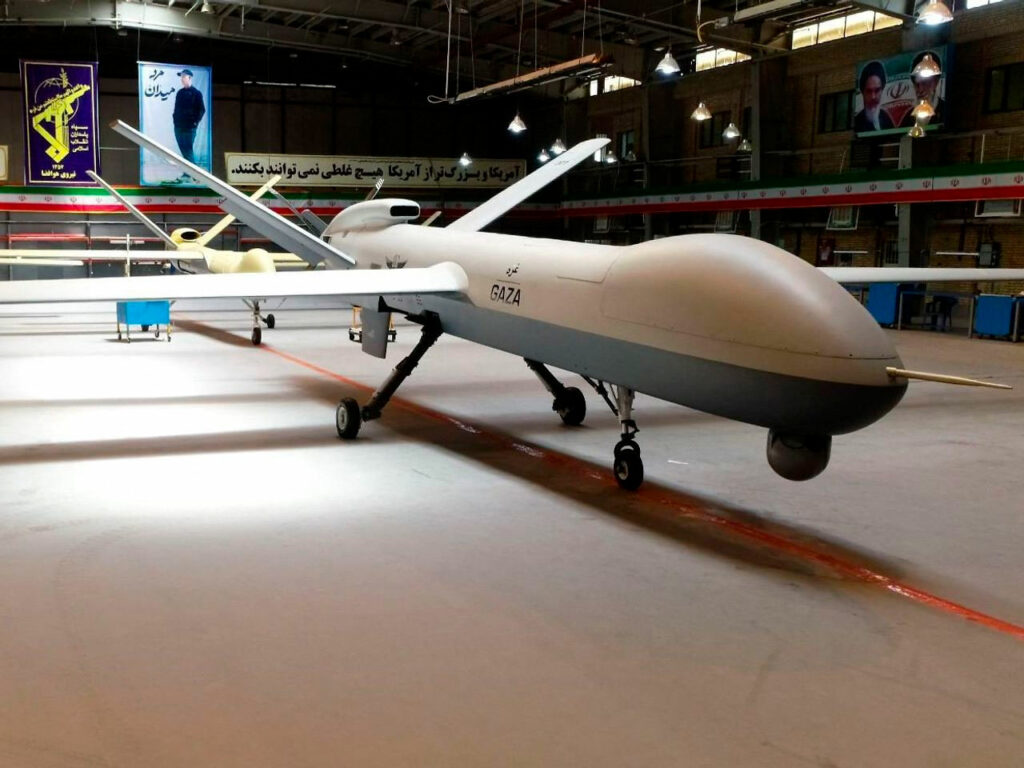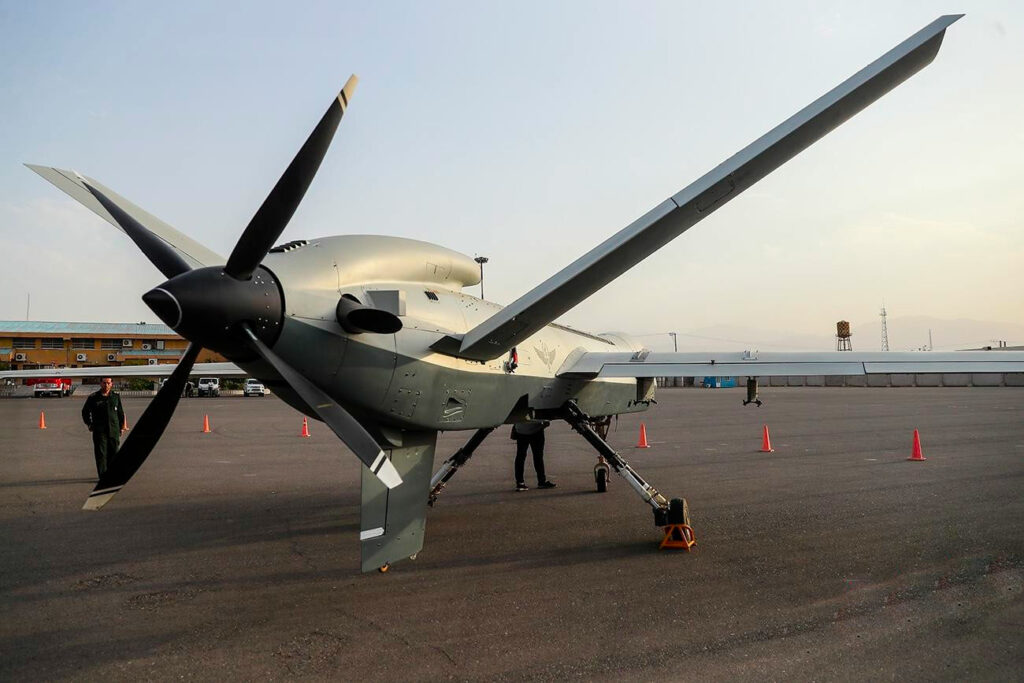The HESA Shahed-149 “Gaza” is an Iranian high-altitude, long-endurance unmanned combat aerial vehicle capable of carrying 13 bombs and 500 kg of electronic equipment.
The HESA Shahed-149 “Gaza” is an Iranian unmanned combat aerial vehicle (UCAV) developed by the Iran Aircraft Manufacturing Industries Corporation (HESA). Unveiled in May 2021, it serves as a high-altitude, long-endurance platform for both reconnaissance and strike missions. The drone features a wingspan of 21 meters (68.9 feet) and is powered by a turboprop engine, marking it as Iran’s first UAV with such propulsion. It boasts a maximum speed of 340 km/h (211 mph) and an endurance of up to 35 hours, allowing for extensive operational reach. The Shahed-149 can carry up to 13 bombs and 500 kilograms (1,102 pounds) of electronic equipment, enhancing its versatility in various mission profiles.
History of the Development of the HESA Shahed-149 (Gaza)
In the early 21st century, Iran intensified efforts to enhance its unmanned aerial capabilities, aiming to reduce reliance on foreign technology and bolster its defense autonomy. The development of the Shahed-149 emerged from this strategic initiative.
The project was initiated by the Iran Aircraft Manufacturing Industries Corporation (HESA), a subsidiary of the Iran Aviation Industries Organization (IAIO). The primary objective was to create a UCAV that could perform long-endurance reconnaissance and precision strike missions, thereby filling a critical gap in Iran’s aerial warfare capabilities.
The Shahed-149 was officially unveiled on May 21, 2021, during a ceremony attended by high-ranking officials from the Islamic Revolutionary Guard Corps (IRGC). The drone was named “Gaza” in honor of the Palestinian enclave, reflecting Iran’s political support for the Palestinian cause amid the 2021 Israel-Palestine crisis.
Following its unveiling, the Shahed-149 underwent a series of flight tests to validate its design and performance parameters. By April 2022, the drone had successfully completed these evaluations and was subsequently delivered to the IRGC Aerospace Force for operational deployment.
The development of the Shahed-149 reflects Iran’s broader strategy to advance its indigenous military technology. By investing in domestic UAV programs, Iran aims to enhance its strategic capabilities and assert its presence in regional and global defense arenas.

Design of the HESA Shahed-149 (Gaza)
The Shahed-149 “Gaza” features a design that emphasizes endurance, payload capacity, and versatility. Its structural and aerodynamic characteristics are tailored to support extended missions and diverse operational requirements.
Airframe and Dimensions:
- Wingspan: 21 meters (68.9 feet)
- Length: 10.5 meters (34.4 feet)
- Height: 3.2 meters (10.5 feet)
The drone’s airframe is constructed using lightweight composite materials, enhancing its durability while minimizing weight. The high-aspect-ratio wings contribute to improved aerodynamic efficiency, facilitating longer flight durations.
Propulsion:
The Shahed-149 is powered by a turboprop engine producing approximately 750 horsepower. This engine drives a four-bladed propeller configured in a pusher arrangement, which reduces aerodynamic drag and enhances fuel efficiency.
Payload and Armament:
The drone is equipped with multiple hardpoints capable of carrying up to 13 precision-guided munitions. Additionally, it can accommodate 500 kilograms (1,102 pounds) of electronic equipment, enabling it to perform electronic warfare and intelligence-gathering missions.
Avionics and Sensors:
The Shahed-149 integrates advanced avionics systems, including:
- Electro-optical/infrared (EO/IR) sensors for day and night surveillance
- Synthetic aperture radar (SAR) for ground mapping and target identification
- Communication systems for real-time data link transmission
These systems enhance the drone’s situational awareness and targeting precision.
Advantages and Drawbacks:
Advantages:
- Extended Endurance: The drone’s ability to remain airborne for up to 35 hours allows for prolonged surveillance and strike missions.
- Significant Payload Capacity: Carrying up to 13 bombs and substantial electronic equipment enables versatile mission profiles.
- Indigenous Development: Domestic production reduces reliance on foreign technology and potential supply chain vulnerabilities.
Drawbacks:
- Limited Speed: With a maximum speed of 340 km/h (211 mph), the Shahed-149 may be less effective in scenarios requiring rapid response.
- Detection Risk: The relatively large size and turboprop engine may increase the likelihood of detection by advanced air defense systems.
Overall, the design of the Shahed-149 “Gaza” reflects a balance between endurance, payload capacity, and operational versatility, aligning with Iran’s strategic objectives for unmanned aerial platforms.
Performance of the HESA Shahed-149 (Gaza)
The HESA Shahed-149 “Gaza” is a high-altitude, long-endurance unmanned combat aerial vehicle (UCAV) developed by Iran. Its performance characteristics are designed to support extended reconnaissance and strike missions.
Engine and Power:
- Engine Type: Turboprop
- Horsepower: Approximately 750 hp
Speed:
- Maximum Speed: 340 km/h (211 mph)
- Cruise Speed: 350 km/h (217 mph)
Altitude:
- Service Ceiling: 11,000 meters (36,089 feet)
Range and Endurance:
- Operational Range: 2,500 km (1,562 miles)
- Endurance: Up to 35 hours
Payload Capacity:
- Armament: Capable of carrying up to 13 bombs
- Electronic Equipment: 500 kg (1,102 lbs)
Comparison with Similar UCAVs:
The Shahed-149 “Gaza” is comparable to the American MQ-9 Reaper in terms of role and capabilities. The MQ-9 Reaper has a maximum speed of approximately 482 km/h (300 mph), a service ceiling of 15,240 meters (50,000 feet), and an endurance of up to 27 hours. While the Reaper offers higher speed and altitude capabilities, the Shahed-149 provides longer endurance, allowing for extended mission durations.
In terms of payload, the MQ-9 Reaper can carry up to 1,700 kg (3,748 lbs) of mixed ordnance, including Hellfire missiles and laser-guided bombs. The Shahed-149’s payload capacity is slightly lower, but it is equipped to carry a significant number of munitions and electronic equipment, enhancing its versatility in various mission profiles.
Overall, the Shahed-149 “Gaza” offers a balance between endurance and payload capacity, making it a valuable asset for long-duration missions requiring persistent surveillance and strike capabilities.

Variants of the HESA Shahed-149 (Gaza)
As of now, there are no officially recognized variants of the Shahed-149 “Gaza.” The current model serves as a multi-role platform capable of performing both reconnaissance and combat missions. Future developments may lead to specialized versions tailored for specific operational requirements, such as enhanced electronic warfare capabilities or increased payload capacity.
Military Use and Combat of the HESA Shahed-149 (Gaza)
The Shahed-149 “Gaza” is designed to perform a variety of military roles, including intelligence, surveillance, target acquisition, and reconnaissance (ISTAR) missions, as well as precision strike operations.
Armament:
The drone is equipped with multiple hardpoints capable of carrying up to 13 precision-guided munitions. These include the Sadid-345 glide bombs, which are lightweight, precision-guided munitions designed for accuracy against both stationary and moving targets. Each Sadid-345 bomb weighs approximately 34 kg (75 lbs) and utilizes electro-optical and GPS-assisted navigation systems to achieve a circular error probable (CEP) of 2.5 to 5 meters.
Operational Use:
In January 2025, during the “Great Prophet 19” military drills, the Shahed-149 “Gaza” demonstrated its operational capabilities by successfully engaging multiple mock targets with high precision. The drone was seen taking off, executing precise strikes on designated ground targets with Sadid-345 bombs from high altitude, and returning to land with precision. This exercise showcased the drone’s ability to conduct coordinated attacks and its effectiveness in a combat scenario.
Comparative Analysis:
When compared to other UCAVs in service, such as the American MQ-9 Reaper, the Shahed-149 “Gaza” offers competitive capabilities in terms of endurance and payload capacity. While it may not match the Reaper’s speed or service ceiling, its extended endurance allows for prolonged operations, which is advantageous for persistent surveillance and extended mission profiles.
Export and Current Status:
As of now, there is no public information indicating that the Shahed-149 “Gaza” has been exported to other countries. The drone is currently in service with the Islamic Revolutionary Guard Corps (IRGC) Aerospace Force. There is no indication that it has been replaced or is planned to be replaced by another aircraft in the near future.
The HESA Shahed-149 “Gaza” represents a significant advancement in Iran’s unmanned aerial vehicle technology. Its design focuses on extended endurance, substantial payload capacity, and versatility in mission profiles. While it may have certain limitations in speed and altitude compared to some counterparts, its ability to conduct prolonged operations with a diverse array of munitions positions it as a formidable asset in Iran’s military arsenal. The successful integration of this UCAV into operational drills underscores its readiness and potential impact on future military engagements.
Back to the Drones, UAVs, UCAVs page